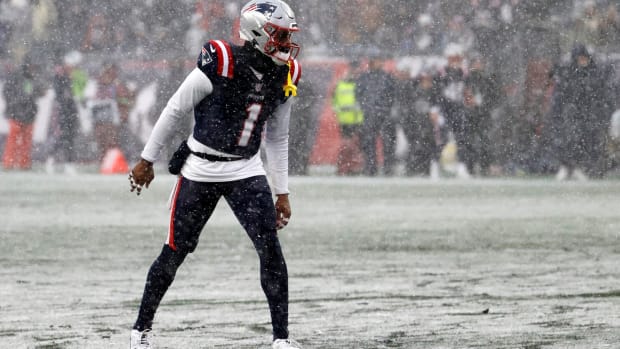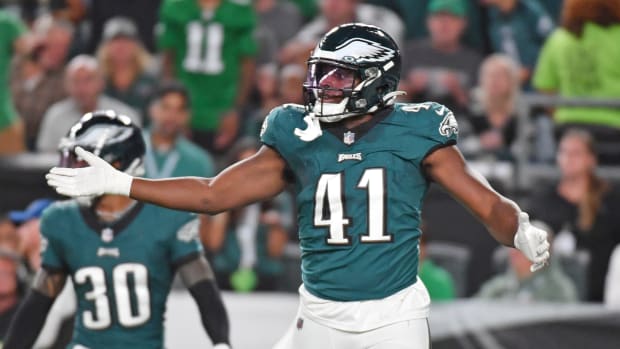Maxwell? Smart
In Week 14 last year, Chip Kelly watched the Seahawks come into Lincoln Financial Field and hold his high-powered offense to a paltry nine first downs and 139 yards. There were many stars for the Seahawks that evening, the brightest being cornerback Byron Maxwell. The then 26-year-old was stifling in man coverage, not just on the perimeter but also in the slot, where few knew he could play. His long arms and innate strength, mixed with technique he’d honed significantly over the past year, made him the exact type of man-press corner that’s caused problems for Philly’s wideouts since Kelly’s arrival.
This loss turned out to be the first of three straight for the Eagles, who stumbled to a 10-6 finish and missed the postseason. During this collapse, Kelly saw his cornerbacks, most notably left side starter Bradley Fletcher, get torched downfield again and again. With Fletcher painfully vulnerable over the top, offenses smelled blood and started exposing some of Philly’s other man-to-man defenders.
Eventually, defensive coordinator Billy Davis lost faith in his club’s man coverage. He became hesitant to dial up the trademark pressure concepts of his variegated nickel and dime sub-packages. In a way, this felt like seeing Grant Achatz reduce his menu to burgers and chicken wings. The Eagles’ defense was built on Davis’s play-calling creativity. They’d given offenses fits with unique twists on traditional ploys. Examples: inside blitzes with top pass rushers, Connor Barwin and Trent Cole, being the A-gap attackers rather than standard edge rushers. There’d also been unusual spy and green-dog blitz tactics—often with Barwin or inside backer Mychal Kendricks, but also with others. These usually came out of an amoeba front. Even the Eagles’ base 3-4 could be multifarious, particularly along the line, where Davis moved around his biggest-bodied men according to opponents’ specific running tendencies.
This is exactly how Kelly wants to play. Being an offensive-minded coach, he hired Davis, a 3-4 aficionado, to conduct a diverse, high-volume defense. But as Kelly and Davis learned the hard way in 2014, you can’t play this way without trustworthy defenders in the secondary. So it came as no surprise this offseason when the Eagles lured Maxwell, a free agent, with a six-year, $63 million contract, making the former sixth-round pick the fifth-highest paid corner in football. Fletcher left in free agency, and fellow starter Cary Williams, who never quite met expectations in his two years as an Eagle, was released. (He wound up replacing Maxwell in Seattle, signing for three years and $18 million.)
Needing to fill the void opposite Maxwell, the Eagles spent a second-round pick on lanky Utah corner Eric Rowe. It’s clear Kelly and Davis want to be physical on the perimeter. Think of the Eagles as the Seahawks East. That’s a great formula for disrupting an offense’s timing early in the down, which meshes perfectly with amoeba fronts and pressure-based concepts.
Like the Seahawks, the Eagles play a lot of single-high coverages. But while the Seahawks tend to be schematically basic inside, the Eagles in 2015 might be even more diverse than they were a year ago. They have the miscellaneous man-to-man defenders that lend flexibility to a coverage and blitz designs. Free safety Malcolm Jenkins, for example, can cover tight ends one-on-one and on occasion drop down to face wide receivers in the slot.
Then there’s Kiko Alonso, acquired from the Bills in the LeSean McCoy trade. Alonso’s sophomore season was wiped out by a July ACL injury, but he was phenomenal as a rookie in 2013, showing fluid change-of-direction and range to cover ground between the hashmarks and to the flats. Assuming he’s healthy, he can become an elite inside linebacker.
Barwin, an outside linebacker, also lends possibilities in coverage, which is unusual for a man coming off a 14.5-sack season. His numbers are not indicative of his playing style, though. While a very smart and effective pass rusher—both off the edge and via blitz—Barwin is most valuable as a movable chess piece, lending disguise and pliability to the scheme’s front. Though much better in zone than man, he can be asked to cover running backs and tight ends on an island (in certain instances).
We’re talking about an Eagles’ back seven that’s potentially stout outside and is certainly athletic and versatile inside. It’s a great combination for winning in obvious passing situations—of which there should be plenty given that Philly’s defensive line is the best three-man run-stopping group in the NFC. Defensive end Fletcher Cox wins with penetration thanks to his initial quickness and his well-honed technique, which amplifies his strength to get off blocks. Opposite him, Cedric Thornton is a monster who gets put in a lot of favorable scenarios via flexible pre-snap alignment. Most defensive ends would kill to get the one-on-one matchups Thornton draws against tight ends. And anyone whom Thornton takes on (assuming he’s the same size) is unlikely to match his nimbleness. At nose tackle, third-year pro Bennie Logan possesses rare lateral movement for someone with 315 pounds and the raw power to match.
Philly’s cumulative defensive numbers will rarely look good because Kelly’s fast-paced offense puts the D on the field for extra snaps. (Extra snaps, of course, often means more yardage, and sometimes even more points allowed.) But make no mistake: this team, known for its offense, can now win games on the strength of its defense. Assuming its expensive new corner lives up to expectations.
Eagles Nickel Package
1. It’s hard to buy that the Eagles always wanted Sam Bradford as their quarterback. If they believe in the 27-year-old, why not sign him to a long-term deal now, while his market value is low? Most likely, Bradford was acquired as a token in an eventual trade to get Marcus Mariota who, if healthy, could also be a better fallback piece than the much slower Nick Foles. Chip Kelly might publicly downplay the significance of quarterback mobility in his scheme, but in order for him to run the full breadth of his ground concepts, mobility is vital. Mostly because Kelly likes to run read-option off an unblocked defensive tackle instead of an unblocked defensive end. With a defensive tackle being aligned several yards closer to the QB, you must have a QB who’s capable of scampering away.
2. Kelly can still employ a menacing ground game without a mobile quarterback. We saw that in 2013, when the Eagles led the league in rushing. Ideally, Kelly wants to run the ball 40 times a contest, even if he’s not able to use all of his rushing concepts. That’s why he got rid of leading receivers DeSean Jackson and Jeremy Maclin and acquired running backs DeMarco Murray and Ryan Mathews. Neither of these backs is as dynamic as LeSean McCoy, but both are more inclined to hit the hole the way Kelly wants.
3. The holes Murray and Mathews will attack will often be on straight inside zone runs. That means double-teams at the point of attack. Last season, injuries left the Eagles thin along the O-line and, consequently, inconsistent in this department. Trying to generate any sort of stability from his rushing attack, Kelly dialed up more man-blocking concepts, often featuring twin pull-blockers from the inside. This is a strong tactic with Jason Kelce being the most mobile center in the game. The question is whether guards Andrew Gardner and Allen Barbre can keep up. If they can’t, Kelce’s mobility will be synced more often with left tackle Jason Peters. That means more screen concepts, not just for the running backs but also tight ends and wide receivers. Screens emphasize Kelly’s M.O. of stretching defenses horizontally in order to create interior voids.
4. What will Darren Sproles’s role be in 2015? There won’t be many handoffs available for the quick-footed 11-year veteran. And with Josh Huff improving in the slot, plus Jordan Matthews getting regular snaps there in the base three-receiver sets, it’s hard to see Sproles touching the ball on misdirection concepts as a wide receiver. Last season, Sproles caught 2.7 passes a game. Take out his career-high 152 yards receiving in Week 2 against the Colts, and he averaged less than 17 receiving yards an outing. Such paltry production does not match his unique physical abilities.
5. One final note on the defense: it was a great move to re-sign Brandon Graham. Stylistically, he’s Trent Cole, just five years younger. (Cole is now in Indianapolis.) Graham, however, has never played an everydown role for a full 16-game season. So it’s important that last year’s first-rounder, Marcus Smith, make at least some noise as a backup edge rusher. Smith spent most of his rookie season learning the unfamiliar inside linebacker position, which, in hindsight, seems like a total waste. With the third-round selection of Jordan Hicks in this year’s draft, the signing of ex-Packer Brad Jones and possible return of veteran DeMeco Ryans (Achilles), the Eagles have depth behind Kendricks and Alonso. Too bad Smith will be adjusting back to the outside rather than building on what he learned as a rookie.
• Questions or comments? Email us at talkback@themmqb.com





































